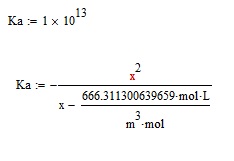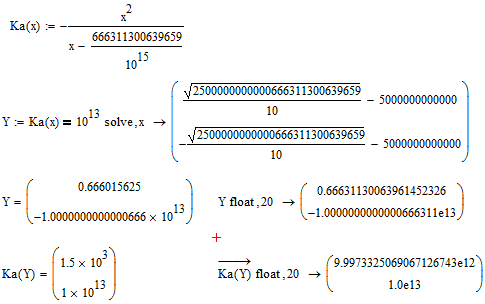Community Tip - You can subscribe to a forum, label or individual post and receive email notifications when someone posts a new topic or reply. Learn more! X
- Subscribe to RSS Feed
- Mark Topic as New
- Mark Topic as Read
- Float this Topic for Current User
- Bookmark
- Subscribe
- Mute
- Printer Friendly Page
Having issue with solving in terms of another variable
- Mark as New
- Bookmark
- Subscribe
- Mute
- Subscribe to RSS Feed
- Permalink
- Notify Moderator
Having issue with solving in terms of another variable
I have attached what I have so far. At the bottom I have come to the point where I want to solve for x with a given Ka. I am stuck on this one.
Solved! Go to Solution.
- Labels:
-
Other
Accepted Solutions
- Mark as New
- Bookmark
- Subscribe
- Mute
- Subscribe to RSS Feed
- Permalink
- Notify Moderator
As for the check: Both solutions pass, but there is some numeric roundoff for the positive one. Not surprising if you consider the coefficients of your quadratic equations are in the range of 10^12, 10^13 and you provide just 12 or 13 decimals of the constant in the denominator.
Generally numeric evaluation (as opposed to symbolic one) is limited to 16-17 decimals anyway.

- Mark as New
- Bookmark
- Subscribe
- Mute
- Subscribe to RSS Feed
- Permalink
- Notify Moderator
Like the attached using a simple Given/Find solve block?
- Mark as New
- Bookmark
- Subscribe
- Mute
- Subscribe to RSS Feed
- Permalink
- Notify Moderator
Not quite, I am looking to either solve symbolically for x= something in terms of Ka, or for actual answer of x. The last two equations on your page get off track somehow. I also find it hard to believe that x is a negative number. I don't think it is solving correctly.
- Mark as New
- Bookmark
- Subscribe
- Mute
- Subscribe to RSS Feed
- Permalink
- Notify Moderator
The formula does return a positive and negative value for x.
Attached is a symbolic solution which returns the same answer as Werner.
Note I have remove the empirical unit handling.
- Mark as New
- Bookmark
- Subscribe
- Mute
- Subscribe to RSS Feed
- Permalink
- Notify Moderator
Something must be off though, because when I type the answer for x back into the original equation, it does not return with the correct value of Ka.
edit: I'm not sure if I was using the correct notation originally. The bold equal sign may be incorrectly used in this case.
- Mark as New
- Bookmark
- Subscribe
- Mute
- Subscribe to RSS Feed
- Permalink
- Notify Moderator
- Mark as New
- Bookmark
- Subscribe
- Mute
- Subscribe to RSS Feed
- Permalink
- Notify Moderator
- Mark as New
- Bookmark
- Subscribe
- Mute
- Subscribe to RSS Feed
- Permalink
- Notify Moderator
Im really not quite sure what is going on in that sheet. I am a beginner and I think this is probably a bit easier than what that looks like. Here is what it can really simplify down to. The only two variables are Ka and x, the other things are just units. I want to solve for x.

- Mark as New
- Bookmark
- Subscribe
- Mute
- Subscribe to RSS Feed
- Permalink
- Notify Moderator
Its basically a quadratic equation you want to solve. So there are two solution - given the value of Ka you supplied, one solution for x is negative around -10^13, the other is positive (around 0.666).
I used the symbolic solve and because I assumed you would be interested in the positive solution, I used the command assume, x>0 to omit the negative solution. If you delete this assume statement, you get both solutions in a 2x1 vector - give it try.
I also used the variable M in the equation instead of the copied value - hope thats what you intended.
In fact I first tried to use a solve block like Mike has done, but I wasn't able to find a guess value which would yield the positive solution.
There is a big drawback in using the symbolic solver - it doesn't know anything about units and sees m, L and mol as unknown variables. Its able to cancel mol, but not m^3 and L. Thats why I told the symbolic solver to substitute L by 10^-3 m^3. That way all units can be cancelled and we get the scalar solution as expected.
As you demanded also a symbolic solution, you either have to solve before you define Ka or make Ka unknown to the symbolics by writing Ka:=Ka.
Here you are - the symbolic solution, followed by both solution in their numeric representation:

- Mark as New
- Bookmark
- Subscribe
- Mute
- Subscribe to RSS Feed
- Permalink
- Notify Moderator
As for the check: Both solutions pass, but there is some numeric roundoff for the positive one. Not surprising if you consider the coefficients of your quadratic equations are in the range of 10^12, 10^13 and you provide just 12 or 13 decimals of the constant in the denominator.
Generally numeric evaluation (as opposed to symbolic one) is limited to 16-17 decimals anyway.

- Mark as New
- Bookmark
- Subscribe
- Mute
- Subscribe to RSS Feed
- Permalink
- Notify Moderator
Ok, thank you for your help. I think I get it now.
- Mark as New
- Bookmark
- Subscribe
- Mute
- Subscribe to RSS Feed
- Permalink
- Notify Moderator
Great explanation Werner ![]()
- Mark as New
- Bookmark
- Subscribe
- Mute
- Subscribe to RSS Feed
- Permalink
- Notify Moderator
Mike Armstrong wrote:
Great explanation Werner
Maybe, but at least partially wrong. The number of decimals provided for the constant has nothing to do with the roundoff errors.
And strange enough - forcing the symbolics in exact mode by providing the constant as fraction of integers makes it even worse - at least the numeric eval.
Also note the difference between the numeric and symbolic evaluation of Y.

- Mark as New
- Bookmark
- Subscribe
- Mute
- Subscribe to RSS Feed
- Permalink
- Notify Moderator
Not good at all.
- Mark as New
- Bookmark
- Subscribe
- Mute
- Subscribe to RSS Feed
- Permalink
- Notify Moderator
The calculations simply are too close to Mathcads numerics precision limits.





